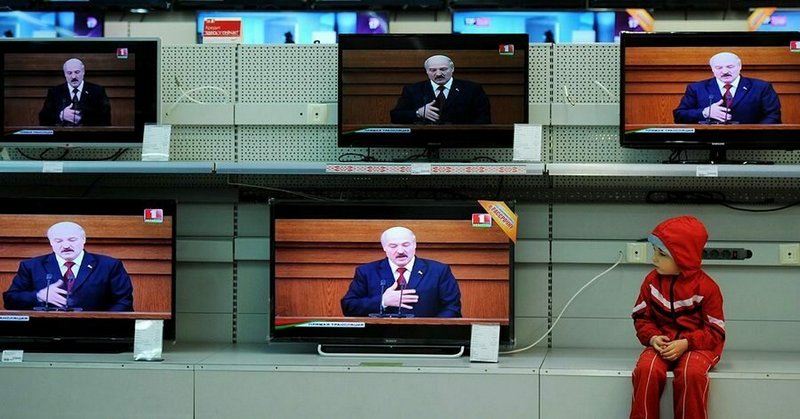What’s really behind “bundling of regional editorial offices” announced by Ministry of Information?
This week, the Ministry of Information stated the need for bundling regional newspapers. It is justified by the “difficulty to attract expensive specialists” to the provinces. However, it looks like another stage of degradation of the state print press and an attempt to save funds, most of which are now directed to the TV propaganda apparatus. The Belarusian Association of Journalists investigated the issue.
Optimization on paper – cuts in reality
In its Telegram channel, the Ministry seems convinced of the need to stimulate editorial offices in the provinces: “The principal editorial offices of the holding will take over the functions and tasks that regional editorial offices cannot assume or master effectively: Internet, social media, design, modern layout”.
According to officials, “it is difficult to attract expensive specialists – SMM workers, PR specialists, designers, artists – to the provinces,” and “the work must be transferred to the principal editorial office of the holding”.
If translated from the official language, it means transferring certain tasks from the print press to some joint centers, which will deal with the design and distribution of content. The tone of the message seems to justify the unpopular decision for a reason. In fact, editorial offices will lose some of their staff (layout designers, SMM staff, etc.), while the state will be able to save money.
Similar processes in the state press system resulted in the previously large publications’ loss of agency and dependence on former competitors who gained access to additional resources.
Now the “transformation” has descended to a lower level, from the national to the regional press.
This assumption is supported by financial plans: this year, the state budget forecasts spending 64.4 million US dollars on state-run media, with just $3.6 million allocated to the print media. A huge piece of the pie goes to television and radio – $52.8 million. The rest will be spent on “other” media (state-run Telegram channels and affiliated vloggers).
What does this mean? In the eyes of the authorities, the state-owned print media are losing influence, and a premium is placed on television productions dominated by propagandist shows.
Thus, the National State TV and Radio Company is to receive $47.7 million, the Mir TV and Radio Company – $3.8 million, and the Second National TV Channel – $1.8 million.
Interestingly, the STV channel will get almost five times more funds than in 2022 ($1.5 million). This is the best evidence of how the “enthusiasm” of regime promoters Ryhor Azaronak, Yauhen Pustavy, and Aliaksei Dzermant is assessed.
It should also be noted that the state print press is not the only sector affected by the “optimization”. While at the end of last year the number of newspapers, magazines, and almanacs registered with the Ministry of Information made around 1200, now there are only 963 print media, of which 403 are state-owned and 560 are private.
This happened against the background of imposing political censorship on independent newspapers, such as Narodnaya Volya, Svobodnye novosti plus, Novy chas, BelGazeta, Komsomolskaya pravda v Belarusi, and Belorusy i rynok.
Who is entitled to complain about “pessimisation”?
However, the degradation of the system of both state and non-state press is of no concern for Information Minister Uladzimir Piartsou who recently complained about the “pessimisation of digital information by American special services.”
“In 2020, ‘true’ [the Ministry of Information’s Telegram channel deliberately scare-quoted the word – Author’s note] media used digital platforms to evoke certain emotions in people,” the official said. “But such synthetic emotions quickly arise and as quickly fade away – that’s the mechanics. This level of confrontation, hybrid media influence, and the growing military threat across the perimeter of our country warns us that the next battle will not be as soft as in 2020.”
The regulating authorities’ dreams to take control of the information space have long extended to social media and messengers.

Last fall at the so-called Young Journalists’ Forum in Hrodna, Piartsou called for social media and messengers to obtain legal status in the country of their operation.
“To begin with, we need to have them ‘land’ in our country: start an office, register a legal address, and be physically present with people who conduct business activities and with whom one can negotiate. Currently, we do not have such social media. However, public and private negotiations are conducted with many market players,” he said.
The authorities are probably well aware that shutting down “extremist resources” is a palliative that the user can easily bypass if necessary, without leaving much of a digital footprint. What would accommodate the state to a larger extent is the possibility to directly influence the owners of social media and messengers and remove undesired content bypassing local representatives.
In fact, it is the independent media that should really complain about “pessimisation”. Most of them were declared extremist, the editorial offices were forced to relocate to other countries, and over 400 journalists have to work abroad.
Blocking independent media sites in Belarus causes the Google search engine to push them down in search results, while propaganda publications appear much higher. This issue has been repeatedly raised in correspondence with representatives of the American company but has not yet been solved.
 @bajmedia
@bajmedia

